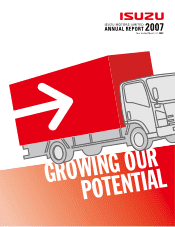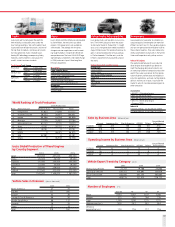Isuzu 2007 Annual Report Download - page 5
Download and view the complete annual report
Please find page 5 of the 2007 Isuzu annual report below. You can navigate through the pages in the report by either clicking on the pages listed below, or by using the keyword search tool below to find specific information within the annual report.
Isuzu Motors Limited Annual Report 2007
ELF light-duty trucks have remained at the cutting edge
throughout every stage of their history, pioneering
numerous technologies that would go on to become
standard in the industry. The history of the ELF is the
history of light-duty trucks in Japan. Here’s a brief look
back at the evolution of the ELF, from its initial launch
in 1959 to the current sixth-generation design.
Pioneering the light-duty
cab-over-engine design
The ELF was the first domestically produced light-duty
truck with a full cab-over-engine design. The new con-
figuration allowed for a larger bed, dramatically im-
proving cargo-loading efficiency.
1959 First-generation ELF
• First cab-over-engine design in its class
• 1.5-liter engine
1968 Second-generation ELF
Featuring a swirl chamber-type diesel engine (DE)
• Change from preheating combustion to swirl cham-
ber type engine
• Full-synchro, 4-speed manual transmission and stan-
dard brake hydromaster
1972 ELF Mypack, Japan’s first FWD
light-duty truck
1975 Third-generation ELF
• Redesigned ergonomic cab
• Compliant with revised safety standards
• Advertisements featured “Tora-san” actor Kiyoshi
Atsumi.
1979
• Quick on System (QOS, a system for reducing
preheating time at startup)
1984 Fourth-generation ELF
Featuring a white, urban-inspired design
• Fuel injection for all models
Pioneering white as a body color
The fourth-generation ELF combined a linear design
with a white body color. Other manufacturers followed
Isuzu’s lead, and white became the standard color for
light-duty trucks in Japan.
1990 First front independent suspension
in its class
1993 Fifth-generation ELF
Featuring the “Aero Cube” look
• People- and environment-friendly design with
enhanced safety
1959 First-generation ELF
1968 Second-generation ELF
1975 Third-generation ELF
Retracing the brilliant evolution of the ELF
1993 Fifth-generation ELF
1995 Total production surpasses 3 million
1999 ELF reaches No. 1 market share
V30 achieved
• Compliant with 1998 Japanese emission regulations
• Compliant with mid-term brake safety regulations
• Standard drivers-side airbag
2001
• Standard dual-mode manual transmission in most
models
• Mechanism for eliminating unnecessary idling
2002
• ELF KR
• Common rail ultra-high-pressure fuel injection
• PM catalytic converter
• First model in Japan to meet 2003 emissions
regulations
2004
• Proprietary next-generation “Smoother E”
transmission
• Ultra-low PM Emissions Diesel Vehicle certification
ELF leads in environmental performance
and safety
ELF contributed to the evolution of the light-duty
truck with ideas that consistently prove to be well
ahead of their time, including a wide cab, front in-
dependent suspension, common rail electronically-
controlled fuel injection, and the “Smoother E”
transmission.
2006 Sixth-generation ELF
Evolving along with the DE
Isuzu took the lead in using the DE as a power plant
for light-duty trucks, and the ELF evolved along with
DE technologies such as direct injection. ELF models
also delivered dramatically improved starting per-
formance with features like Isuzu’s Quick on System
(QOS).
Total production passes 5 million
Since its launch in 1959, the ELF has met the de-
mands of the times and the needs of the market with
innovative technologies. Brisk sales at home in Japan
and in 120 countries worldwide have pushed total
production past 5 million. With No. 1 market share in
Japan and many other countries, this bestselling truck
plays an important supporting role in international
distribution.
1984 Fourth-generation ELF
2006 Sixth-generation ELF
03


















